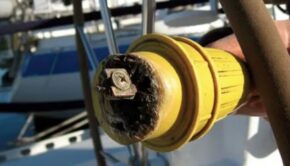MAINTENANCE: Caring for Encapsulated Ballast Keels
Published on April 18th, 2013
By Darrell Nicholson, Practical Sailor
It’s getting warm enough now in most places up north that we can start thinking about getting some actual work done on the hull – thinking about. I checked the weekend in Duluth, Minn., and it still looks a bit chilly for curing epoxy. You’d think that maintenance chores wouldn’t snowball during the off season, but the freeze and thaw cycles of fall-winter-spring take their toll. One of those places where this becomes most evident is at the keel.
We’ve written a lot about keels recently, and over the years, we’ve offered tips on repairs to common problems like the C&C “smile,” when a lead keel pulls away from the keel stub, or how to deal with voids in lead keels. I’ve also written here about the effectiveness of rust converters such as Ospho when reviving an iron keel.
PS’s April boat test of the Gulfstar 36 (subscribers only) got me thinking about encapsulated keels again. A lot of people like the idea of having lead (preferably) or other ballast material encapsulated. Island Packet is probably the most familiar builder today that uses an encapsulated-ballast keel. IP uses lead, a far better choice than iron or concrete (or sand!), or the mish-mash of all three that I found in a 1970s-era Taiwanese-built boat. One big advantage of having an encapsulated keel is that so long as the fiberglass and waterproof coatings remain intact, they don’t require any special seasonal maintenance.
However, fiberglass is permeable, and on some older boats, water tends to find its way into the ballast. If the ballast is iron, the results can be ugly as the metal oxidizes and expands. Having a two-part epoxy barrier coat like the Interlux Interprotect system goes a long way toward preventing this kind of problem.
The chief maintenance concern with an encapsulated keel, though, is damage from a grounding. Sometimes this damage is so minor you might not even notice it, or might mistake it for chipped paint.
Fortunately, it’s not too hard to fix this sort of damage. For those who own or are thinking of buying a boat with an encapsulated keel, below I’m re-running an excerpt from the archives about spotting and repairing minor damage to encapsulated keels. – Read on








 We’ll keep your information safe.
We’ll keep your information safe.